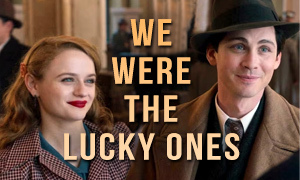Masters of the Air: History vs. Hollywood
Austin Butler
Born: August 17, 1991
Birthplace:
Anaheim, California, USA
Maj. Gale 'Buck' Cleven
Born: December 27, 1918
Birthplace: Lemmon, South Dakota, USA
Death: November 17, 2006, Sheridan, Wyoming, USA
Bio: Commander of the 350th Bomb Squadron, 100th Bomb Group
Isabel May
Born: November 21, 2000
Birthplace:
Santa Monica, California, USA
Marjorie Spencer
Born: 1920
Birthplace: Wyoming, USA
Death: August 23, 1953, Coffeyville, Kansas, USA (brain aneurysm)
Bio: Maj. Gale Cleven's Future Wife
Callum Turner
Born: February 15, 1990
Birthplace:
London, England, UK
Maj. John 'Bucky' Egan
Born: September 9, 1915
Birthplace: Manitowoc, Wisconsin, USA
Death: April 1961, Virginia, USA (heart attack)
Bio: Commander of the 418th Bomb Squadron, 100th Bomb Group
Anthony Boyle
Born: June 8, 1994
Birthplace:
Belfast, Northern Ireland, UK
Lt. Harry Crosby
Born: April 18, 1919
Birthplace: New England, North Dakota, USA
Death: July 28, 2010, Nahant, Massachusetts, USA
Bio: Lead Navigator of 100th Bomb Group
Barry Keoghan
Born: October 18, 1992
Birthplace:
Dublin, Ireland
Lt. Curtis Biddick
Born: April 20, 1915
Birthplace: Livingston, Wisconsin, USA
Death: August 17, 1943 (killed in action piloting a B-17 during Regensburg Mission)
Bio: Pilot in the 418th Bomb Squadron, 100th Bomb Group
Nate Mann
Born: 1995
Birthplace:
Los Angeles, California, USA
Maj. Robert 'Rosie' Rosenthal
Born: June 11, 1917
Birthplace: Brooklyn, New York, USA
Death: April 20, 2007, White Plains, New York, USA
Bio: Pilot in 418th Bomb Squadron, 100th Bomb Group | Lawyer who Later Interviewed Hermann Göring During Nuremburg Trials
Rafferty Law
Born: October 6, 1996
Birthplace:
Westminster, London, England, UK
Sgt. Kenneth Lemmons
Born: December 29, 1922
Birthplace: Pocahontas, Arkansas, USA
Death: December 17, 2004, Rockford, Illinois, USA (COPD)
Bio: Ground Chief with 351st Squadron, 100th Bomb Group
How did Gale 'Buck' Cleven and John 'Bucky' Egan meet?
Portrayed by Austin Butler and Callum Turner in Masters of the Air, a fact-check confirms that Gale 'Buck' Cleven and John 'Bucky' Egan met each other when they were assigned to room together at flying school in the spring of 1940. They enlisted in the United States Army Air Forces before the December 7, 1941 attack on Pearl Harbor, less out of patriotism and more because they had grown up dreaming of flying planes. It was Egan who gave Cleven the nickname "Buck" because he thought he looked like someone from back home. Egan was first called "Bucky" as a cadet because a colleague thought he looked like a man with that name. Together, they were referred to as the "two Buckys."
According to Lt. Harry Crosby's memoir via Smithsonian Magazine, the two airmen were "dashing, undisciplined, superb pilots, exactly what Hollywood expected them to be." Established in 1942, both men were assigned to the 100th Bombardment Group, which was made up of 37 crews, each with 10 men.
Is Masters of the Air based on a book?
Yes. The true story told in the nine-episode Apple TV+ miniseries is based on the 2006 book of the same name by Donald L. Miller. The full title of the book is Masters of the Air: America's Bomber Boys Who Fought the Air War Against Nazi Germany. Steven Spielberg and Tom Hanks were executive producers on the series, which is a follow-up to Band of Brothers (2001) and The Pacific (2010). It had been in the making for over a decade.
When did the 100th Bombardment Group conduct its first bombing raid of WWII?
After completing training, the 100th departed for Norfolk, England toward the end of May 1943. A little over two weeks after they arrived, they took part in their first bombing raid on June 25, 1943. Initially, the United States Army Air Forces conducted precision raids, targeting the German war machine, including aircraft factories, U-boat pens, and ball-bearing plants. The British Royal Air Force, on the other hand, executed night bombings of German cities as retaliation for Germany's Blitz bombing campaign that devastated London.
What was the role of each member of a B-17 crew?
The American B-17 crews of the 100th Bombardment Group were made up of 10 men, including the pilot, co-pilot, navigator, bombardier, radio operator and gunners.
Did Major Gale 'Buck' Cleven tell his co-pilot, "You son of a bitch, you sit there and take it," when his co-pilot wanted to bail out?
Yes. This comes directly from the Masters of the Air true story and was recounted when President Franklin D. Roosevelt presented Major Cleven with the Distinguished Service Cross for his "extraordinary heroism" in connection with the bombing of ground targets in Bremen, Germany on August 17, 1943. During the mission, Cleven was the leader of the low squadron and endured "approximately two hours of constant fighter attack." Roughly 30 minutes before reaching his target, his B-17 Heavy Bomber suffered severe damage when it was hit in succession by six shells, which resulted in partial loss of control and left his radio operator dead and several others critically injured.
Still facing fresh waves of enemy fighters, his crew, which was partially made up of inexperienced youngsters, wanted to bail out. His co-pilot repeatedly pleaded with him to abandon ship. Though they were facing almost certain death, Cleven replied, "You son of a bitch, you sit there and take it." His stern words were heard over the plane's inter-phone, which inspired the crew to remain in the fight. They made it to Bremen, bombed their target, and landed safely at a base in North Africa.
Did the 100th Bomb Group suffer major losses?
Yes. While they had major successes, they indeed suffered heavy losses, so much so that they were nicknamed the "Bloody Hundredth". As seen in the series, it's true that many of the veteran airmen refused to get to know the new recruits because they didn't want to lose more friends. While exploring the Masters of the Air fact vs. fiction, it's worth recognizing that the 100th Bomb Group didn't suffer the most losses of all the groups in the Eighth Air Force. That unwanted title went to the 91st Bomb Group, which lost a total of 197 planes, 20 more than the 100th. Why then was the 100th Bombardment Group called the "Bloody Hundredth"? The moniker stuck because the 100th suffered huge losses all at once. They would go several months without any major blows and then lose half their men during a single mission.
Was Major Gale Cleven captured by the Germans after he was forced to bail out of his B-17?
Yes. While on a mission to Bremen, Germany on October 8, 1943, Major Gale 'Buck' Cleven was forced to bail out of his B-17 when it was hit by flak and fighters and had to abandon formation. They lost the No. 2 engine, part of the left wing was blown off, and control cables were severed as shells tore through the nose. They tried to pitch all of their gear to lighten the load, but due to further attacks, Cleven was unable to make it to the Dutch border. All 11 men on board, three of whom were injured, bailed out and landed close to Essen, Germany.
According to the American Air Museum, it's true that Buck Cleven landed at the front door of a farmhouse and found himself lying on his back with a pitchfork pressed against his chest. He tried to convince the farmer that he was one of the good guys, but it didn't work. He was taken to a Luftwaffe station where he was interrogated with other members of his crew. On October 23, 1943, he was transferred to Stalag Luft III in Sagan, Germany (today the town is called Żagań and is part of Poland).
Did the 100th Bomb Group lose a staggering 12 of 13 B-17s during the Allied bombing raid on Münster, Germany?
Exhausted and depleted from raids on Bremen and Marienburg over the course of the previous two days, aircraft from the Eighth Air Force took off for the bombing raid on Münster, Germany on October 10, 1943. For the first time, the target was a city center instead of military and industrial targets. As seen in episode five, it's true that many of the airmen were conflicted that they would be bombing civilians, even if the justification was that a large number of German rail workers resided there. Making it more difficult to justify was the fact that the target was the steps of a medieval cathedral around the time that mass was letting out. Others, including Major John Egan (portrayed by Callum Turner in the series), were excited by the mission and saw it as a way to avenge the deaths of so many of their friends. According to the National WWII Museum, Egan later remarked:
Others who had lost close friends in the past few raids joined in the cheering because here was a chance to kill Germans, the spawners of race hatred and minority oppression. It was a dream mission to avenge the death of a buddy.
Just six of the 100th Bomb Group's 13 B-17s that were deployed made it to the city center of Münster. Others fell prey to the more than 350 German aircraft that had amassed to stop them, a number many had not seen on their previous missions. A Masters of the Air fact-check corroborates that Major John Egan was forced to bail out of his doomed aircraft. He was captured by the Germans and sent to Stalag Luft III in Poland where he joined his best friend, Major Gale Cleven. The remaining planes from the 100th brought up the rear of the 13th Combat Wing formation that also included bombers from the 95th Bomb Group and the 390th. Together, they devastated the city center, igniting fires in Münster that would burn for days. Over 700 civilians are believed to have been killed during the raid. Of the 13 B-17s from the 100th, only one, the plane of new arrival Maj. Robert Rosenthal, made it back. The enormous loss suffered by the 100th Bombardment Group cemented their reputation as the "Bloody Hundredth".
In total, the 13th Combat Wing lost 25 of 30 bombers during the Mission to Münster. The 95th Bomb Group lost five of 17, the 390th lost eight of 17, and the 100th Bomb Group lost a devastating 12 of 13 planes and one-quarter of their airmen. Over the course of the three days of raids that the Eighth Air Force took part in from October 8th - 10th, they lost 88 B-17s and nearly 900 airmen, the worst losses in their history to that point.
When John Egan arrived at Stalag Luft III did his best friend, Gale Cleven, welcome him by saying, "What the hell took you so long?"
Yes. Though it might seem like a line created by Hollywood, according to the true story described by the American Air Museum, Maj. Gale 'Buck' Cleven indeed greeted his buddy this way when Maj. John 'Bucky' Egan arrived at Stalag Luft III, a Luftwaffe-run prisoner-of-war camp in Sagan, Germany. "What the hell took you so long?" Cleven said to Egan. The two men were part of the more than 35,000 airmen of the United States Army Air Forces who were held as prisoners of war by Germany and its allies during the Second World War. Approximately 28,000 of these POWs were members of the Eighth Air Force, the division to which Cleven and Egan belonged.
Why didn't American fighter planes accompany the bombers and defend them on the missions?
Fighters, including P-47s, did escort the B-17s part of the way, but they lacked the range to make it the whole way to the targets and back. Therefore, the bombers flew in large formations with the hope that they would have safety in numbers. They often encountered waves of Luftwaffe attacks and were sitting ducks against the German fighter planes that had far greater maneuverability. However, by December 1943, P-51 Mustangs were able to protect the B-17 bombers along their whole route. When the Luftwaffe would converge on a formation of bombers, they would be picked off by the P-51s. By the time of the D-Day invasion on June 6, 1944, the Luftwaffe had been virtually wiped out. As the Allies advanced inland from Normandy, they were not significantly disrupted by enemy aircraft.
Did many of the men in the 100th suffer from PTSD?
Yes. In answering the question, "Is Masters of the Air accurate?" it's true that many of the men suffered psychologically from the stresses of aerial combat. Referred to as "combat fatigue" at the time, many of the men suffered from what today is known as post-traumatic stress disorder. Serving in the United States Army Air Forces was more dangerous than being an infantryman. Soldiers and Marines on the ground had more control over their fate and their response to the enemy. They also had more immediate access to medical care.
Commenting on the many airmen who were killed or missing, actor Anthony Boyle states as Lt. Harry Crosby later in the series, "Those of us who continued to fly mission after mission had to tiptoe around their ghosts. Some of the men were coming undone. They'd seen too many planes blow up in front of them, too many men killed." The psychological fallout of combat in the USAAF was previously touched on in the 1949 Gregory Peck film Twelve O'Clock High, which finds Brigadier General Frank Savage (Gregory Peck) taking over command of a bomb group.
Were the Tuskegee Airmen part of the Eighth Air Force that included the 100th Bomb Group?
The Tuskegee Airmen were not part of the Eighth Air Force and the series doesn't imply this. In Masters of the Air on Apple TV+, Tuskegee fighter pilots Robert H. Daniels, Richard Macon and Alexander Jefferson encounter Major Gale Cleven (Austin Butler) and Major John Egan (Callum Turner) while the men are all being held as prisoners of war at Stalag Luft III after being shot down. The filmmakers were interested in exploring whether racial tension still existed between airmen even while they were being held in a German prisoner-of-war camp.
"Everything we found [suggested] there was not the kind of racial tension that I had assumed. Everyone cooperated because they had to," co-producer Kirk Saduski told Smithsonian Magazine. The interaction between the two groups of men in Masters of the Air does not appear in Donald L. Miller's 2006 book on which the series is based and seems to be mostly speculative. The book does discuss racial tensions in the military at the time, including a violent June 1943 encounter in England between MPs and a group of black soldiers who had been out drinking. The altercation resulted in one person being killed.
Did Major Gale Cleven escape his German captors during a march after the evacuation of Stalag Luft III?
Yes. The relationships between the prisoners and Luftwaffe guards at Stalag Luft III in Poland had deteriorated badly after the Great Escape, which was orchestrated by British airmen and resulted in the escape of 76 Allied airmen on the night of March 24/25 1944 (the escape inspired the heavily fictionalized 1963 Steve McQueen film). All but three of the 76 airmen were recaptured. 50 were shot on the orders of Adolf Hitler.
Following D-Day on June 6, 1944, the Allies began closing in from the West and the Russians from the East. On January 27, 1945, the Germans abruptly evacuated the prisoner-of-war camp in order to move the captives to camps further inland. They marched the prisoners in the snow, and it wasn't long before the first American succumbed to the freezing conditions.
During the overall chaos of the winter march, Maj. Gale 'Buck' Cleven (portrayed by Austin Butler in the series), along with two other airmen, managed to escape somewhere on the way to Moosburg, Germany. Twelve days later, Cleven arrived back at the Royal Air Force station Thorpe Abbotts after spending 18 months as a POW. As for his best friend and fellow prisoner, John Egan, he was taken to camps further inland and endured tough conditions until Allied forces liberated the camps in the spring of 1945.
Did Major Gale Cleven and Marjorie Spencer get married?
Yes. Portrayed by Austin Butler (Elvis) and Isabel May (1883) in Masters of the Air on Apple TV+, the real Major Gale Cleven and Marjorie Spencer were married in Lovington, New Mexico on July 3, 1945. Major John Egan acted as the best man. Described as the love of his life, Marjorie died unexpectedly on Sunday, August 23, 1953 in Coffeyville Memorial Hospital in Kansas. She had traveled there to visit her parents and brother.
Marjorie had been spending time with family while her husband was being transferred from a base in Albuquerque, New Mexico to the Morton Army Air Base in San Bernadino, California. She had been ill since the previous Wednesday. Find a Grave lists her cause of death as polio. The 100th Bomb Group Foundation states that she died of a brain aneurysm. It's possible that she had fallen ill after contracting the poliovirus, which led to the aneurysm.







